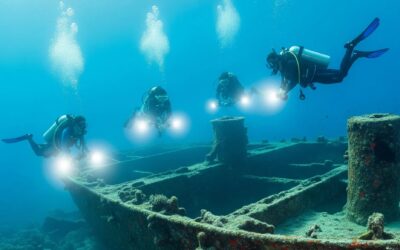The Buoyancy Check
Good buoyancy starts at the surface, even before gearing up. It begins with the decision about the amount of weight you are planning to dive with. Why? Starting a dive properly weighted is probably the most crucial contributing factor to performing good buoyancy while diving. If you begin your dive overweighted, no matter how much you’ve learned about buoyancy, you won’t be able to control yourself. Therefore, let’s begin with a buoyancy check.
If you have not the previous article of the buoyancy series, check it out here.
How to Figure Determine the Right Amount Weight
To determine how much lead you need to be adequately weighted, you should perform a simple buoyancy check. Practicing this under various conditions allows you to learn about yourself as a diver and how those conditions may affect your buoyancy. Anything from changing the configuration of your gear to different water conditions can impact your buoyancy control. The more you practice, the better you will understand your needs.
Performing a Buoyancy Check
The most commonly used method for a buoyancy check on the surface is:
- Position yourself vertical on the surface and deflate your BCD completely
- When holding a normal breath you should float at eye level
- When exhaling you should descent slowly in a controlled manner (straight legs, no fin kicking)
If instead, whilst holding the breath you have trouble keeping your head out of the water, you are most likely using too much weight. If on the other hand the water level remains at your chest you most likely need a bit more weight to reach neutral buoyancy.
Simple, isn’t it? This will quickly give you an idea of whether you are diving with the correct amount of weight. Also check out the Peak Performance Buoyancy Specialty course. Once you’ve done your first buoyancy check, it’s time to add a bit more knowledge.
Factors Affecting Buoyancy
1. Full Tank vs. Empty Tank
A full steel tank generally weighs around 2 kg more than an empty one. Therefore, deciding whether to do a buoyancy check with a full or empty tank will affect how much weight you need. Some divers prefer to start the dive slightly heavier, ensuring they are perfectly weighted for a relaxed safety stop when their tank is low on air. Others prefer to maintain perfect buoyancy throughout the dive, which might make them slightly more positive buoyant at the end.
Tips for Buoyancy Check:
- Perform the check with approx. 50 bar to simulate end-of-dive air conditions.
- Fully fill your lungs, instead of only holding a normal breath, to see if you float at eye level. This means you will require slightly more weight, helping simulate task-loading scenarios during the safety stop.
2. Depth and Buoyancy
As you dive deeper, you may feel more negatively buoyant. This is why some divers prefer to be slightly positively buoyant at the surface to enjoy perfect buoyancy at depth.
Tips for Descent:
- Use Gravity: Empty your lungs, kick up to the surface once, and then let gravity push you.
- Breathe for Sinking: Focus on exhaling to start sinking. Lengthen your exhalation to avoid floating up.
- Swim Down with a Back Kick: If you know how to swim backward, use this technique to help pull yourself down.
- Simply Swim Down: Once your head is slightly underwater position yourself horizontal, slightly facing downwards, and swim until you reach a comfortable depth.
Repetition is The Key to Mastery
Spend time trying out different scenarios, equipment configurations and environments. Learning about yourself and improving as a diver requires time and practice. Remember, repetition is the key to mastery! The good news are, in this case practicing means being underwater and having fun!
Conclusion
Starting a dive properly weighted is perhaps the most crucial factor in achieving good buoyancy. Regular practice of buoyancy checks and understanding how different factors affect your buoyancy will help you become a more proficient and confident diver.
Next step: Perform a perfect controlled descent and enjoy your dive with optimal buoyancy!



